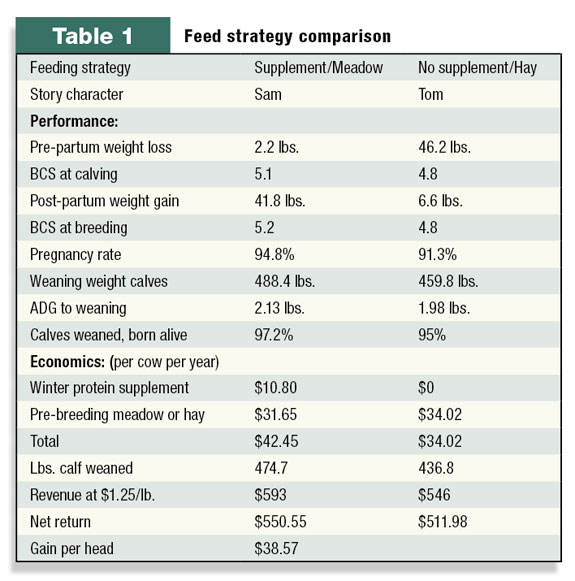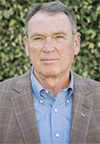
Feeding strategies
One day Tom suggested that he and Sam put an end to the debate by tracking the expenses and revenues from their operations over the next three years, and let net income decide once and for all who was most efficient.
Tom would run his cows on low inputs – no supplements – just winter grazing and hay until grass was on. Sam eagerly agreed. He was confident that the cost of his supplements would result in better body condition, reproduction and profits.
Both ranches had nearly identical cows and the same grazing, hay and calving seasons, so it looked like a fair arrangement.
Sam’s plan was to graze his cows until calving on dormant native range and supplement his cows in December, January and February with one pound per day of a 42 percent protein ($240 per ton).
Cows would calve in March and April and be fed hay (8 percent CP, 56 percent TDN) in a drylot. Sam would then graze a high-quality sub-irrigated meadow the month before breeding begins ($32 per cow).
Tom, on the other hand, knew he might lose some condition in his cows, resulting in a lower conception rate, but he was confident his feed cost-savings would be enough to compensate. Tom grazed the same range as Sam prior to calving, then fed hay in the drylot during calving period and until bull turnout on June 1. The hay for both ranches was valued at $62 per ton.
The results
At the end of the three years, the two friends pulled out their records and began to compare notes. Sam had spent a little over $38,000 for supplement and meadow grazing for his 300-cow herd, and he was unsure he had the results to justify his investment.
Just as they had anticipated, Tom’s cows without supplement, lost 46 pounds in the 90 days before calving, while Sam’s cows maintained their weight. Tom’s body condition score (BCS) at calving was 4.8 compared to Sam’s 5.1.
Sam spent $10.80 per cow per year on supplement. In the month before bulls were turned out, Tom’s cows just maintained their weight on hay alone, fed to meet their appetite while Sam’s cows gained 19 pounds on the meadow and improved BCS to 5.2.
Sam was now feeling better about his total per-cow investment of $42.80 because he knew that a lower BCS at calving should decrease conception rates. He was a little surprised that his herd pregnancy rate of 95 percent was only slightly better than Tom’s 91 percent. He was more surprised that he and Tom’s calves had the same birth weight and the same quality colostrum.
Then they looked at weaning numbers. Sam’s calves were 29 pounds heavier, and he consistently weaned more live calves. In all, Sam had 8 percent more weight to sell at weaning. When the final net returns were figured, Sam had realized about $40 per cow more net income than Tom, $25 attributed to feeding the winter supplement and $15 for grazing early meadows.
In fact, Tom realized he had actually spent more on hay ($34.02) in the 30 days before breeding than Sam did on rented meadow ($31.65). On his herd of 300 cows, Sam’s net return was $12,000 more per year than Tom’s.
Sam of course was happy his investment in extra feeding was validated, but both ranchers were a little confused at the results. They knew that reproduction was driven by energy, and BCS was a good indicator of energy balance. Why, they wondered, weren’t there bigger differences in the conception rates between their herds?
If energy determines body score, why feed expensive proteins? Was there really a connection between feeding programs and weaning percentage and weight, or was that just a fluke?
BCS scores and other considerations
Sam and Tom used the same veterinarian, Dr. Fred Armsalot. He knew their herds well, so they decided to take their questions to him. Dr. Fred was impressed with their data. He figured that although Sam’s BCS scores were better, Tom had been able to keep his cows from dropping to a critical BCS without supplement.
If the weather had been colder or the forage quality poorer, he might not have been so lucky, and, if they had calved at a body condition of 4.5 or less, the reproductive results would have been much more dramatic. It had been his experience that even if cows are a little thin at calving, if they are gaining weight from calving to breeding, then breedback results are pretty good.
Dr. Fred also explained that although energy balance determines BCS, a baseline level of protein is required to keep the rumen bugs efficiently working to maximize digestion of forages. If the rumen bacteria aren’t healthy, the cow utilizes less of the feed she eats, so both protein and energy sources must be balanced properly to feed cows economically.
Dr. Fred’s interpretation of the calf data focused on milk quality and quantity. Since heavier calves that are genetically similar can only be the result of higher caloric intake, Sam’s cows must have been producing more milk. He concluded that Sam’s nutrition program supported more milk, which resulted in heavier calves and calves more resistant to death loss.
Tom and Sam shook hands and parted. They realized that weather conditions, feed quality and feed costs can all have a dramatic effect on which feeding strategy will pay dividends. But in this case the results were clear – protein supplementation prior to calving and breeding put more money in the bank. ![]()
*Based on a three-year study at the University of Nebraska entitled, “Effects of pre- and post-partum nutrition on reproduction in spring calving cows and calf feedlot performance.” The research was published in 2006 in the Journal of Animal Science (84:2582-2589) and the authors are L.A. Stalker, D.C. Adams, T.J. Klopfenstein, D.M. Feuz and R.N. Funston.
Optimized nutrition is the foundation of all health, performance and financial outcomes in beef cow management. At the 2009 Range Beef Cow Symposium, Dr. Jack Whittier from Colorado State University reviewed four time-tested principles that summarize the interaction between nutrition and reproductive performance:
Energy intake has a more direct impact on reproduction than protein level. However, for optimal digestion of forage diets, adequate protein intake is necessary.
Energy intake prior to calving primarily impacts the length of the time before a cow is ready to re-breed. Pre-calving nutrition is best evaluated by body condition score (BCS) at the time of calving.
Nutrition after calving primarily impacts conception rate. BCS at the start of breeding is the best measurement of post-calving nutrition.
Dams that are gaining condition before and after calving will have higher pregnancy rates than if there is no weight gain or weight loss.
The bottom line
Find the most economical way to feed cows and heifers so that they will calve in good condition (BCS 4.75-5.0) and then gain some condition prior to breeding (BCS 5-5.25). If your cows are thinner than these targets, they are costing you more in production than the cost of feed supplementation. If your cows are heavier than these targets, you may be spending more on feed and supplements than is necessary. ![]()
Kevin Hill lives in Utah and can be contacted at 801-547-1634 or kevin.hill@sp.intervet.com

Kevin Hill
Technical Services Vet
Intervet/Schering-Plough Animal Health
kevin.hill@sp.intervet.com







